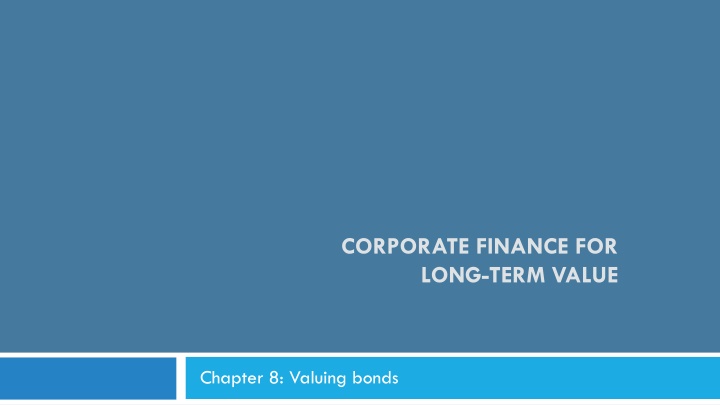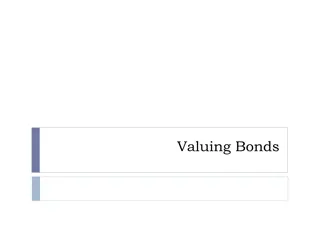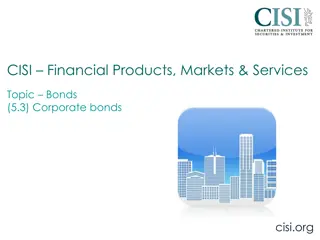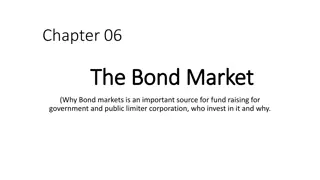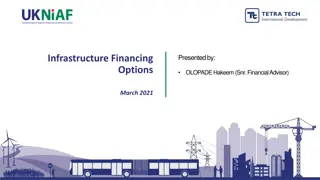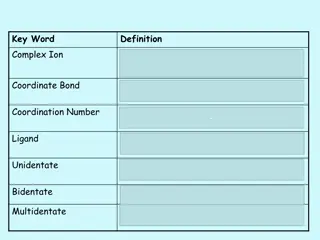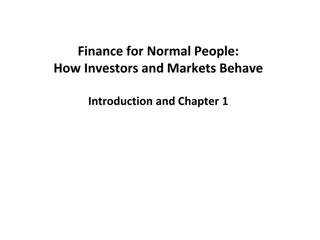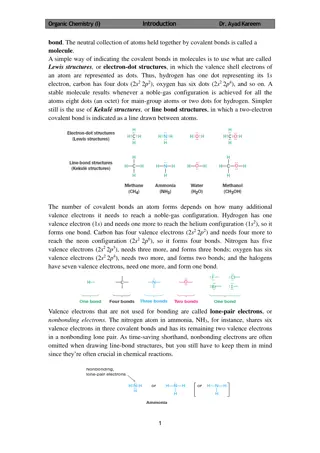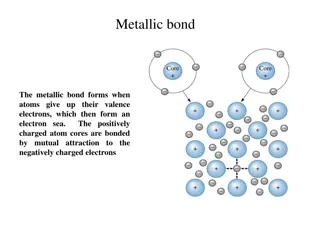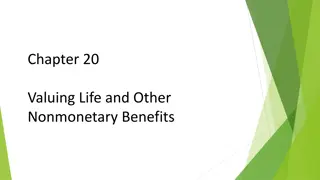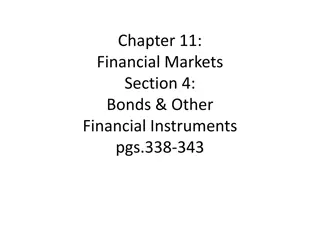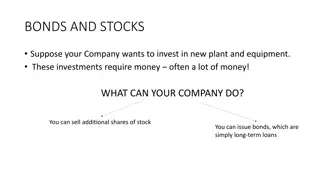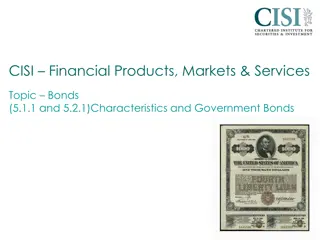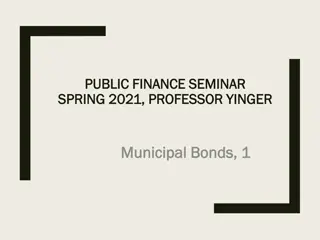Valuing Bonds in Corporate Finance
Dive into the world of valuing bonds in corporate finance with insights on bond markets, bond payments, types of bonds, and bond valuation methods. Understand the significance of bonds as a financing tool for companies and the interplay of government bond yields, credit risk, and sustainability factors in bond valuation.
Download Presentation

Please find below an Image/Link to download the presentation.
The content on the website is provided AS IS for your information and personal use only. It may not be sold, licensed, or shared on other websites without obtaining consent from the author.If you encounter any issues during the download, it is possible that the publisher has removed the file from their server.
You are allowed to download the files provided on this website for personal or commercial use, subject to the condition that they are used lawfully. All files are the property of their respective owners.
The content on the website is provided AS IS for your information and personal use only. It may not be sold, licensed, or shared on other websites without obtaining consent from the author.
E N D
Presentation Transcript
CORPORATE FINANCE FOR LONG-TERM VALUE Chapter 8: Valuing bonds
Part 3: Valuation of companies Chapter 8: Valuing bonds
The BIG Picture 3 Corporate bonds are a key financing tool for companies Traditional valuation Bond investors are more focused on downside protection Government bond yield (benchmark) + spread for credit & liquidity risk = corporate bond yield New valuation Integrate social and environmental factors into credit risk Emergence of green bonds and sustainability-linked bonds
The bond market 4 Bonds are certificates of debt that promise payment of the borrowed amount plus interest by a specified future date Type of securities Outstanding (in trillions of USD) Bonds are issued by: Equity markets 112.1 - Public equity 105.8 A government - Private equity 6.3 A company Bond markets 123.4 - Government bonds 62.8 A financial institution - Corporate bonds 60.6 - Issued by companies 17.0 - Issued by financial institutions 43.6 Sources: SIFMA (2021); McKinsey (2022); BIS debt securities statistics.
Bond payments 5 A bond certificate indicates the amounts and dates of all payments (principal + interest) to be made The maturity date of the bond is the final repayment date, and the time until the maturity date is the term of the bond Two types of payments made on a bond: Promised periodic interest payments, called coupons Principal / face value of the bond, to be paid at maturity
Types of bonds 6 Government / sovereign bonds are issued by national governments (countries) Corporate bonds are issued by companies or financial institutions Secured bonds contain assets as collateral (i.e. mortgage bonds) Unsecured bonds have lower seniority / priority Government bonds Bonds Secured corporate bonds (public debt) Debt Corporate bonds Unsecured corporate bonds Private debt
Bond valuation 7 Bond prices result from discounting promised cash flows The price value of a coupon bond P equals the present value of its coupons plus the present value of the face value FV with maturity N ??? ??? ??? + ?? (1 + ????)? ? = (1 + ???1)+ (1 + ???2)2+...+ ???= the yield to maturity of a zero-coupon bond with the same maturity ??? = the coupon payment, determined by the annual coupon rate ??? and the number of coupon payments per year ?? : ??? =??? ?? ??
Bond valuation 8 Example Coupon payment (CPN): $30 Annual coupon rate (ACR): 6% Number of coupon payments (Nr): 2 Solution ??? =??? ?? = $30 =6% $1,000 ?? 2 coupon of $30 is paid every 6 months remember face value (FV) = $1,000
Bond valuation 9 The coupon payments form a stream of equal cash flows paid at regular intervals, this equals an annuity The present value of a bond becomes the sum of the coupon annuity and the face value The yield to maturity (YTM) or yield (y) is the discount rate that sets the present value of payments equal to its current market price Therefore, the price of a bond with maturity N is: ? = ??? 1 1 ?? ?(1 1 + ??) + (1 + ?)?
Bond valuation 10 The relationship between bond yields and bond prices is maintained through market forces: As interest rates and bond yields rise, bond prices fall And vice versa: As bond yields fall, bond prices increase This means bonds can trade at: A premium a price greater than face value A discount a price lower than face value Par a price equal to face value this is rare!
Zero-coupon bonds 11 The price of a zero-coupon bond is simply the present value of the face ?? value: ? = (1+????)? The yield to maturity of a zero-coupon government bond is used to calculate the risk-free rate
Interest rate changes 12 As interest rates change, bond prices move along with them The effect of interest rate changes is larger for bonds with longer terms The duration of a bond is the sensitivity of a bond s price to changes in interest rates, and the weighted average of the time-length of cash payments The time-length is the number of future years n = 1, 2, 3, .., until maturity N Duration = 1 ?? ??1 + 2 ?? ??2 + + ? ??(???) ?? ?? ?? The weight for each year is the present value ??(???) divided by the total present value ??
Duration 13 Calculating the duration of 5% six-year bond with a YTM of 4% Time 2022 2023 2024 2025 2026 2027 Year 1 2 3 4 5 6 Cash flow 50 50 50 50 50 1,050 0.962 0.925 0.889 0.855 0.822 0.790 Discount factor Total PV = PV(CFn) at 4% 48.1 46.2 44.4 42.7 41.1 829.8 1,057.7 Fraction of total value Year * fraction of total value 0.045 0.044 0.042 0.040 0.039 0.785 Total = 1.0 0.045 0.087 0.126 0.162 0.194 4.708 Total duration = 5.3 Duration (5.3 years) is typically close to maturity (6 years), because of large weight of face value Duration is good measure of interest rate risk of bond, where higher duration reflects higher interest rate risk
Term structure of interest rates 14 The term structure of interest rates (also called yield curve) is the array of yields on bonds with different terms to maturity To derive a 10-year yield curve, you need the YTMnfor year 1, 2, , 10 The yields can be calculated using the formula for zero-coupon bonds: ?? ? = (1 + ????)? The law of one price can be used to calculate the yields on coupon bonds, since similar products should sell at the same price If they don t sell at the same price, arbitrage makes differences disappear
Government bond yield 15 Government bonds are the ?? ? = (1 + ????)? safest and most liquid bonds serve as benchmark risk-free rate Source: World Government Bonds
Yields on coupon bonds with the same maturity 16 Year (n) Bond price (P) Yield (y) Maturity Zero-coupon yield Discount factor Bond A (4% coupon) Payment PV(CFn) Bond B (6% coupon) Payment PV(CFn) Bond C (0% coupon) Payment PV(CFn) 1 2 3 4 2% 0.98 3% 0.94 4% 0.89 5% 0.82 40 39.22 40 37.70 40 35.56 1,040 855.61 4.90% 968.09 60 58.82 60 56.56 60 53.34 1060 872.06 4.85% 1,040.78 0 0 0 0 0 0 1,000 822.70 5.00% 822.70 Bonds differ in terms of coupon rate, but have the same maturity
Yields on coupon bonds with different maturities 17 Year (n) Bond price (P) Yield (y) Maturity Zero-coupon yield Discount factor Bond D (6% coupon) Payment PV(CFn) Bond E (6% coupon) Payment PV(CFn) Bond F (6% coupon) Payment PV(CFn) 1 2 3 4 2% 0.98 3% 0.94 4% 0.89 5% 0.82 60 58.82 1,060 999.15 2.97% 1,057.98 60 58.82 60 56.56 1060 942.34 3.92% 1,057.72 60 58.82 60 56.56 60 53.34 1060 872.06 4.85% 1,040.78 Bonds have the same coupon rate, but differ in terms of maturity
Term structure 18 Since bonds with higher duration carry more interest rate risk, the yield curve is typically upward sloping This leads to a positive term spread, which is the spread of yields for bonds with longer maturity over bonds with shorter maturity This has several explanations: The belief that short-term rates will be higher in the future Higher exposure of longer-term bonds to changes in interest rates Risk of higher inflation in the future
Inflation 19 ( ????,? ????,? 1) ????,? 1 Inflation, ??,?= , is the realised consumer price index (CPI) inflation rate given country ? in year ? The real rate of return ??is calculated as ??=1+? 1+? 1 We can use the approximation for real interest rates in the form of nominal return minus inflation ?? ? ? in low inflation countries For high inflation countries, use the full formula, since larger numbers result in larger deviations
Drivers of yields on government bonds 20 Cantor and Packer (1996) find that sovereign borrowing costs can be explained by: External debt Level of economic development Default history Per capita income GDP growth Inflation Government bonds are typically bought by institutional investors seeking a relatively safe investment Financial contagion is the spread of market disturbances from one market or country to other markets or countries Example: European Sovereign Debt Crisis, originating from Greece in 2009
Government bond yields as risk-free rates 21 The German bond yield is most creditworthy and can be used as the Euro s risk-free rate 8 Euro-sovereign debt crisis 7 in percent 6 5 4 3 2 1 - -1 Jan-08 Jan-09 Jan-10 Jan-11 Jan-12 Jan-13 Jan-14 Jan-15 Jan-16 Jan-17 Jan-18 Jan-19 Jan-20 Jan-21 Jan-22 Germany France Netherlands Italy Source: Bloomberg U.S. government bonds (also called Treasuries) serve as the risk-free rate for the US dollar
Drivers of yields on corporate bonds 22 Compared to government bonds, corporate bonds tend to carry more serious default and liquidity risks Due to lower trading frequencies, higher transaction costs and smaller sizes Due to the risk of default, the bond s 3.5% 3.0% expected return (equal to the firm s 2.5% 2.0% cost of capital) is less than the yield 1.5% 1.0% to maturity YTM 0.5% 0.0% Government bond Corporate bond Expected return Yield to maturity
Drivers of yields on corporate bonds 23 The yield spread is the difference between yields of corporate bonds and yields of government bonds The higher the default risk, the larger the spread 550 Maturity 1 year 5 year 10 year 20 year 500 AAA corporate bonds 4.39% 4.30% 4.39% 4.61% in basispoints 450 A corporate bonds 4.68% 4.66% 4.92% 5.26% 400 AAA Treasuries 4.07% 3.85% 3.65% 4.04% 350 AAA corporate yield spread 0.31% 0.45% 0.75% 0.57% 300 0 5 10 15 20 25 30 A corporate yield spread 0.61% 0.81% 1.28% 1.22% Maturity in years AAA Corporate Bonds A Corporate Bonds AAA Treasuries Source: Bloomberg, as per November 2022
Credit risk 24 Credit risk refers to the risk of default of the entity issuing a bond The expected return on a bond is different from the promised return, as some issuers default on their bond The expected return on debt ??is ? ? = 1 ?? ? + ?? ? ??? = ? ?? ??? = ?? ?? = the probability of default ??? = loss given default (the fraction of the principal and interest lost in case of default)
Credit risk - example 25 The expected return on debt ??is ? ? = 1 ?? ? + ?? ? ??? = ? ?? ??? = ?? Example: assume a promised yield y of 6%, a probability of default PD of 4% and a loss given default LGD of 60% What is the expected return on debt ??? Answer: ??= ? ?? ??? = 6% 4% 0.60 = 3.6%
Credit risk 26 The expected credit losses ??? are calculated by: ??? = ??? ?? ??? ??? = exposure at default The credit risk premium ??? is the investor s reward for risk taking, and is the difference between the expected return on a bond ?[?] and the risk-free rate ??: ??? = ?[?] ??
Yield, credit and liquidity spreads 27 Yield spread is difference between promised Corporate bond yield yield and risk-free (government) yield Expected liquidity costs Liquidity spread Liquidity risk premium The liquidity spread covers: Yield spread Expected credit losses The expected liquidity costs Credit spread The liquidity risk premium Credit risk premium The credit spread covers: The expected credit losses ??? Risk-free rate The credit risk premium ???
Be very precise on credit definitions 28 Corporate bond yield To recap on credit (ignoring liquidity spread) Expected liquidity costs The credit spread covers: Liquidity spread Liquidity risk premium Expected credit losses reflects promised yield Yield spread Expected credit losses minus expected yield: ??? = ? ?[?] Credit spread Credit risk premium is reward for risk-taking: Credit risk premium ??? = ? ? ?? Check: credit spread is ??? + ??? -> Risk-free rate -> ? ?? ? ? ? + ? ? ?? promised yield risk free rate
Example 29 Example One-year corporate bond with yield 7.5%, risk of default 4%, loss given default 60% Calculate expected credit losses and credit risk premium, given government bond yields 3% Solution: Expected yield: ? ? = ??= 7.5% 4% 0.60 = 5.1% 1. Expected credit losses: ??? = ? ? ? = 7.5% 5.1% = 2.4% 2. Credit risk premium : ??? = ? ? ??= 5.1% 3% = 2.1% 3. Check: credit spread is difference between corporate yield (7.5%) and government yield (3%) 4. -> ??? + ??? -> 2.4% + 2.1% = 4.5%
Corporate bonds during times of crises 30 During crises, credit spreads can jump due to higher (perceived) risk of default and/or investor s flight to safety During the 2009 global financial crisis, spreads increased considerably: 800 600 in basispoints 400 200 0 2005 2007 2009 2011 2013 2015 2017 2019 2021 AAA Corporate A Corporate BAA Corporate Source: Bloomberg
Credit ratings 31 Standard & Poor s and Fitch Long-term average default rate Rating agency Moody s Type of bonds Investment grade bonds Aaa AAA 0.00% Aa AA 0.02% A A 0.05% Baa BBB 0.16% Type of bonds Junk or high yield bonds Ba BB 0.61% B B 3.33% Caa CCC Ca CC 27.08% C C
Agency costs 32 Owning the equity of a company is like having the right to buy the company (an option) paying the face value of debt to the bondholders The more debt there is, the riskier that right becomes (Merton, 1974) A benefit for bondholders is that they get paid back first in case of default Equity holders benefit from volatility (risk), while bondholders suffer from volatility or uncertainty Myers (1977) debt overhang problem: if management is aligned with equity holders, it will only attract new capital for projects with high enough returns to leave a residual return for shareholders as well
Liquidity risk 33 Bonds also face liquidity risk, which is the risk that bonds cannot be sold swiftly Liquidity is the ease with which an investor can sell or buy a bond The liquidity spread is the spread between the yield of a bond with high liquidity and a similar bond with less liquidity The higher liquidity risk of corporate bonds stems from lower trading frequencies and higher transaction costs
Integrating sustainability into bond valuation 34 Sustainability issues include value relevant issues (inefficiencies) that are not yet properly priced Compared to equity, the focus in fixed income valuation is much more on risk than on opportunities Environmental and social exposures can have effects on performance by generating risks that may materialise in future scenarios Volkswagen credit default swap (CDS) spread went from 75.5 basis points (bp) to 299.5 after Dieselgate scandal in 2015 Russian CDS spread went from 200-300bp to 600bp after seizing Crimea from Ukraine in 2014, while Ukrainian CDS spread rose to over 5,000bp
From sustainability to credit risk 35 Factors influencing creditworthiness Environmental and social factors Credit risk indicators Cash reserves Profitability Productivity Competitive advantage Cost of capital Leverage Intangibles Etc. Credit ratings CDS spreads Bond yields and prices Volatility Default probability Breach of covenants Etc. Climate change Biodiversity Energy management Pollution Human rights Health & safety Gender gap Etc.
Integrating sustainability into bond valuation 36 Credit risk assessment models estimate the probability of default ?? and the loss given default ??? on the basis of historical data at industry and company level Integrating sustainability is challenging due to its forward-looking nature Factors to include in credit risk analysis: The prospect of internalisation of social and environmental factors companies that internalise factors can reduce credit risk The company s capability to adapt to a sustainable world adaptable companies have a reduced probability of default and loss given default
Altman Z-score 37 The Altman Z-score is a simple method to incorporate sustainability into credit risk assessment (Altman, 2018) Based on four factors: 1. Working capital: ?1=current assets current liabilities total assets 2. Retained earnings: ?2=retained earnings total assets Estimate the impact of sustainability on these four factors 3. EBIT: ?3=earnings before interest and taxes total assets 4. Equity: ?4=book value of equity total liabilities
Altman Z-score 38 Z-score formula: ? = 3.25 + 6.56 ?1+ 3.26 ?2+ 6.72 ?3+ 1.05 ?4 The zones of discrimination: Safe zone: ? > 5.85 company does not go bankrupt Grey zone: 4.35 < ? < 5.85 company is at risk of bankruptcy Distress zone: ? < 4.35 company are (or will be) bankrupt
Evoniks Z-score 39 Problem In 2020, Evonik, a German specialty chemicals company with a large focus on sustainability, had the following current and projected future profile: Factor 2020 2021 2022 Working capital 0.10 0.11 0.11 Retained earnings 0.33 0.40 0.43 EBIT 0.04 0.07 0.07 Equity 0.39 0.39 0.39 What is the impact of Evonik s sustainability strategy on its default risk?
Evoniks Z-score 40 Solution ? ????? = 3.25 + 6.56 ?1+ 3.26 ?2+ 6.72 ?3+ 1.05 ?4 Factor Weight 2020 2021 2022 Safe zone: ? > 5.85 Constant 1.00 3.25 3.25 3.25 Grey zone: 4.35 < ? < 5.85 Working capital 6.56 0.10 0.11 0.11 Distress zone: ? < 4.35 Retained earnings 3.26 0.33 0.40 0.43 EBIT 6.72 0.04 0.07 0.07 Equity 1.05 0.39 0.39 0.39 Z-score 5.66 6.16 6.25 Evonik s Z-score of 5.66 in 2020 indicates the company is in the grey zone The improvement in 2021 and 2022 means Evonik moves to the safe zone
Integrated value calculation 41 Graph shows IV and its Integrated value components: FV, EV, SV FV: enterprise value EV SV High debt and negative Components of E x their price Components of S x their price Equity Debt values of S and E raise risk 50 of both debt and equity 40 30 20 S and E factors can be 10 0 internalised and spill over EV+ EV- SV+ SV- Debt Equity -10 -20 into financial value -30 -40
Case-studies integrated value calculation 42 Case-studies integrated value Value Inditex IV calculation (Euro billions) Ch6-7 project valuation 79 FV (enterprise value) Ch11 company valuation Inditex 283 Positive SV Make DCF for enterprise value FV -137 Negative SV Make DCF for SV + EV -183 Negative EV Integrate numbers 42 IV (integrated value) Ch18 attempted take-over of Unilever by Kraft Heinz
Green bonds 43 The purpose of green bonds is to finance environmentally friendly (green) projects The green bond market has grown exponentially, reaching a global annual issuance of $520 billion in 2021 Market value of issuance per year, US$ billions Issuers include: 600 Supranationals (i.e., World Bank, IMF, EIB) Amount in $ billions 500 400 Agencies 300 Governments 200 Municipalities 100 Corporates 0 Financial institutions Year
Green bonds 44 Criteria for green bonds, as set out by ICMA (2021): Use of proceeds: proceeds are exclusively for green projects, which should be appropriately 1. described in the legal documentation accompanying the security Process of project evaluation and selection: the issuer should clearly communicate to 2. investors: What the environmental objectives are The process by which the issuer determines how the project fits within eligible green project categories The related eligibility criteria Management of proceeds: the net proceeds of the green bond should be credited to a sub- 3. account, and subsequently tracked and verified Reporting: mandatory reporting on the use of the proceeds 4.
EU Taxonomy for sustainable activities 45 The EU Green Bond Standard specifies that green products should contribute to at least one of six environmental objectives: Climate change mitigation 1. Climate change adaptation 2. Sustainable use and protection of water and marine resources 3. Transition to a circular economy 4. Pollution prevention and control 5. Protection and restoration of biodiversity and ecosystems 6. A green project should not undermine any of the objectives The EU Green Bond Standard also requires verification of the allocation of the proceeds to green projects by an external party
Green bonds 46 Sustainable investors are prepared to pay a green bond premium, resulting in a lower yield known as the clientele effect Green bond premium is the difference in yield between green bonds and perfectly matched reference bonds Green bond premium typically ranges from 0 to 20bp and averages around 5bp Benefits for issuers is partly offset by higher issuing and reporting costs, also estimated around 5bp per year Green bonds is more about signaling greenness, than saving on borrowing costs
Social bonds 47 Social bonds need to provide clear social benefits They are a payment by results contract where an organization (with a social purpose) agrees to deliver outcome on a social project If the objectives are not reached, investors do not receive a return nor repayment of the principal Social project categories include, but are not limited to: Food security Affordable basic infrastructure Socioeconomic advancement Access to essential services Empowerment Affordable housing Employment generation
Sustainability-linked bonds 48 Sustainability-linked bonds can be used for the issuer s general purposes They incorporate forward-looking sustainability key performance indicators (KPIs) and sustainable performance targets -> expected to be way forward Improvement in KPIs leads to lower interest rate payments (i.e. a lower yield) Label Green bonds Social bonds Sustainability bonds Sustainability-linked bonds Format Use of proceeds Use of proceeds Use of proceeds Entity KPI-linked A combination of green and social projects
Conclusions 49 The pricing of bonds is relevant for corporate finance for two reasons: The yield on government bonds serves as the risk-free rate Companies issue bonds to finance their operations Bond markets are bigger than stock markets, with institutional investors typically holding more bonds than equity Companies that can better adapt their business model face a lower credit risk There is innovation in the form of green bonds and social bonds to cater for sustainable investment projects of governments and companies
